
UX REQUIREMENTS MADE SIMPLE
My proven method for smarter, UX-focused product requirements (and a lot less stress).
What UX struggles would you love to end?
- Do you want to stop the endless cycle of rework to satisfy stakeholders’ moving targets?
- Would you like to play a role in creating requirements instead of having them handed to you like written law?
- Are you tired of delivering products with UX defects you know could have been avoided?
- Do you wish there was a way to get managers to agree to UX work at the start of the project, instead of tacking it on at the end, when it’s too late?
If you answered YES to any of those questions, you’re in the right place. I created this course specifically to end the vicious cycle too many developers and product teams are trapped in: vague requirements they had no hand in creating, constant rework and a never-ending stream of new (and changing) requirements.
See, I’ve been there myself. In nearly 30 years of working with organizations of all sizes in nearly every industry, I know that cycle all too well. I know what it’s like to try and roll the “UX rock” up that hill only to have your stakeholders or managers or clients roll it back down again.
No more debate about when UX work should happen.
I know the pain of fighting to get UX included at the start of a project all too well. And I also know that it’s entirely possible to put an end to it.
UX Requirements Made Simple will show you how to get a seat at the requirements table, open the minds and ears of your managers or clients, and see a massive change in both the quality of requirements and the success of the delivered product.
In the time it takes to watch a great movie, you‘ll learn to:
- Use faster, simpler methods to generate, validate and prioritize requirements, resulting in a build or MVP that clearly demonstrates the power of good UX — from the very first sprint onward.
- Integrate user research and validation into an existing, development-centric product design process — without a fight!
- Get a clear, solid sense of what users really need — even if you have no budget to do user research.
- Easily identify the "sweet spots" where features and functionality deliver maximum value, great UX for users and ROI to the business.
- Learn a simple way to get managers and clients to listen to your UX recommendations — and act on them.
- Replace cumbersome, formal tools with clear, simple exercises that uncover true UX needs and get everyone on the same page, sharing the same UX goals and understanding their importance.
- You’ll see how easy it is to quickly integrate strategic UX validation into an existing requirements process — without the need for additional time, money or resources.
WHAT YOU'LL LEARN
Here’s just some of what you’ll learn:
- Poor methods for requirements that rely on a broken engineering process — and a better, simpler set of methods that get to clarity and value quickly.
- Why what users say they need isn’t what they actually need (and how to tell the difference).
- Poor requirements tools that address task completion instead of success — and a smarter set of tools that focus your work squarely on desired outcomes.
- How to get managers or clients (or your team) to ask the right questions, instead of jumping to solutions based on their personal opinions.
- How to create contextual use scenarios that tell the real story of the user’s journey from start to finish — and extract relevant functional needs and elements that make up valuable requirements.
It’s simple, it’s straightforward, and it works.
Not because I say it does — but because the Enterprise teams I’ve taught to use these methods have gotten the results I’m talking about. It works because more than 280,000 students (yes, that’s a real number) tell me that my courses have changed the work they do for the better.
Why?
Because I deal in software development reality instead of UX fantasy. Perfect situations where we can do these well-funded deep dives into UX research don’t exist for a vast majority of development teams, and I’m really tired of hearing everyone pretend otherwise. So everything I deliver is based in reality, in the less-than perfect world most of us live in.
22 Lessons
Already Joined? Login
Introduction: Overview (and Why We're Here)

Course Overview: What You'll Learn

Why Traditional Requirements Produce Mediocre Products

Download the Requirements Workbook
Why Requirements Fail: The Culprits
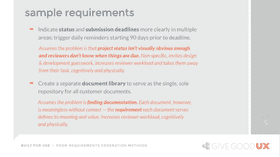
Poor Methods of Requirements Generation

Poor Tools for Requirements Generation
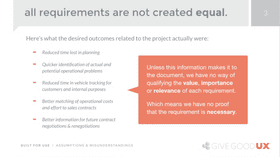
Assumptions and Misunderstandings: What Requirements Really Are
The Three Kinds of UX Requirements
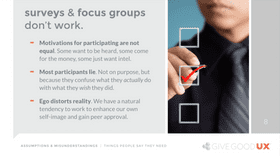
What People Say They Need

What People Actually Need

What People Don't Know They Need
Turning User Behavior, Motivation and Situation into Functional Needs
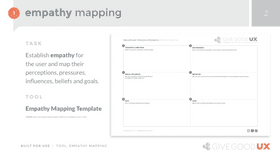
Empathy Mapping: Uncovering User Needs

EXERCISE: Create an Empathy Map
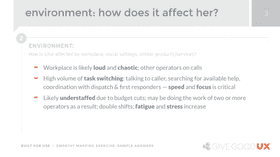
Sample Answers: Empathy Map Exercise
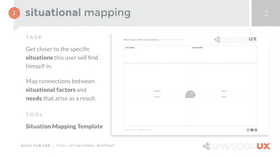
Situational Mapping: Uncovering Context of Use

EXERCISE: Create a Situational Map
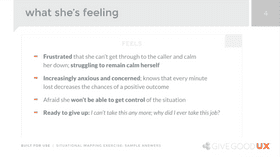
Sample Answers: Situational Mapping Exercise
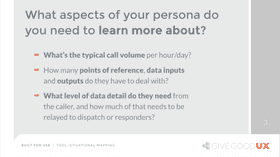
Wrap Up: Empathy & Situation Mapping
Leveraging the Power of Contextual Use Scenarios
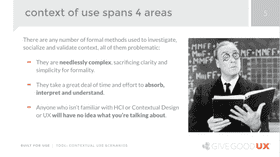
The UX Silver Bullet: Context (and Contextual Use Scenarios)

Communicating Use: Creating Visual Workflow Scenarios

Generating Functional Requirements from Use Scenarios
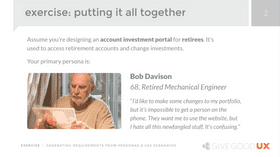
EXERCISE: Generating Contextual Requirements
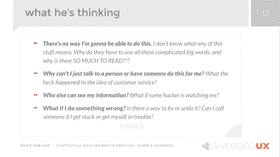
Sample Answers: Generating Contextual Requirements
Mantras: If You Forget Everything Else...
